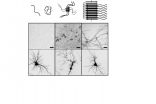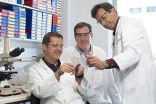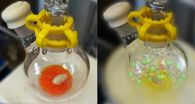Neural activity predicts the timing of spontaneous decisions
Researchers have discovered a new type of brain activity that underlies the timing of voluntary actions, allowing them to forecast when a spontaneous decision will occur more than a second in advance
2014-10-01
(Press-News.org) Researchers have discovered a new type of brain activity that underlies the timing of voluntary actions, allowing them to forecast when a spontaneous decision will occur more than a second in advance. 'Experiments like this have been used to argue that free will is an illusion, but we think that this interpretation is mistaken,' says Zachary Mainen, a neuroscientist at the Champalimaud Centre for the Unknown, in Lisbon, Portugal, who led the research, published on Sept. 28, 2014, in the journal Nature Neuroscience.
The scientists used recordings of neurons in an area of the brain involved in planning movements to try to predict when a rat would give up waiting for a delayed tone. "We know they were not just responding to a stimulus, but spontaneously deciding when to give up, because the timing of their choice varied unpredictably from trial to trial", said Mainen. The researchers discovered that neurons in the premotor cortex could predict the animals' actions more than one second in advance. According to Mainen, "This is remarkable because in similar experiments, humans report deciding when to move only around two tenths of a second before the movement."
However, the scientists claim that this kind of predictive activity does not mean that the brain has decided. "Our data can be explained very well by a theory of decision-making known as a 'integration-to-bound' model," says Mainen. According to this theory, individual brain cells cast votes for or against a particular action, such as raising an arm. Circuits within the brain keep a tally of the votes in favor of each action and when a threshold is reached it is triggered. Critically, like individual voters in an election, individual neurons influence a decision but do not determine the outcome. Mainen explained: "Elections can be forecast by polling, and the more data available, the better the prediction, but these forecasts are never 100% accurate and being able to partly predict an election does not mean that its results are predetermined. In the same way, being able to use neural activity to predict a decision does not mean that a decision has already taken place."
The scientists also described a second population of neurons whose activity is theorized to reflect the running tally of votes for a particular action. This activity, described as "ramping", had previously been reported only in humans and other primates. According to Masayoshi Murakami, co-author of the paper, "we believe these data provide strong evidence that the brain is performing integration to a threshold, but there are still many unknowns." Said Mainen, "what is the origin of the variability is a huge question. Until we understand that, we cannot say we understand how a decision works".
INFORMATION:
ELSE PRESS RELEASES FROM THIS DATE:
2014-10-01
The peptide —a small protein— beta-amyloid is strongly associated with Alzheimer's disease; however, researchers are still looking for unequivocal proof that this peptide is the causal agent of the onset and development of the disease. The main obstacle impeding such confirmation is that beta-amyloid is not harmful when found in isolation but only when it aggregates, that is when it self-assembles to form the so-called amyloid fibrils
"We are not dealing with a single target, beta-amyloid alone, but with multiple ones because each aggregate of peptide, which can go from ...
2014-10-01
Current changes in the ocean around Antarctica are disturbingly close to conditions 14,000 years ago that new research shows may have led to the rapid melting of Antarctic ice and an abrupt 3-4 metre rise in global sea level.
The research published in Nature Communications found that in the past, when ocean temperatures around Antarctica became more layered - with a warm layer of water below a cold surface layer - ice sheets and glaciers melted much faster than when the cool and warm layers mixed more easily.
This defined layering of temperatures is exactly what is ...
2014-10-01
An international team of scientists has shown that more than 80 per cent of bowel cancers could be treated with existing drugs.
The study found that medicines called 'JAK inhibitors' halted tumour growth in bowel cancers with a genetic mutation that is present in more than 80 per cent of bowel cancers. Multiple JAK inhibitors are currently used, or are in clinical trials, for diseases including rheumatoid arthritis, psoriasis, blood cancers and myeloproliferative disorders.
Bowel cancer is the second-most common cancer in Australia with nearly 17,000 people diagnosed ...
2014-10-01
DURHAM, N.C. -- A Duke University team has found that nanoparticles called single-walled carbon nanotubes accumulate quickly in the bottom sediments of an experimental wetland setting, an action they say could indirectly damage the aquatic food chain.
The results indicate little risk to humans ingesting the particles through drinking water, say scientists at Duke's Center for the Environmental Implications of Nanotechnology (CEINT). But the researchers warn that, based on their previous research, the tendency for the nanotubes to accumulate in sediment could indirectly ...
2014-10-01
Computer modelling of the human eye, the brain of a rat and a robot could revolutionise advances in neuroscience and new technology, says a QUT leading robotics researcher.
Dr Michael Milford from QUT's Science and Engineering Faculty says the new study uses new computer algorithms to enable robots to navigate intelligently, unrestricted by high-density buildings or tunnels.
"This is a very Frankenstein type of project," Dr Milford said.
"It's putting two halves of a thing together because we're taking the eyes of a human and linking them up with the brain of a rat.
"A ...
2014-10-01
An international group of researchers led by Dr. Warren E. Piers (University of Calgary) and Dr. Heikki M. Tuononen (University of Jyväskylä) has been able to isolate and characterize an important chemical intermediate whose existence has, so far, only been inferred from indirect experimental evidence.
Chemical reactions rarely go from starting materials to final products in one single step, but instead they progress through a number of intermediates. In many cases the intermediates are not stable enough to be studied by conventional characterization methods, which thwarts ...
2014-10-01
Philadelphia, PA, October 1, 2014 – Patients with increased inflammation, including those receiving cytokines for medical treatment, have a greatly increased risk of depression. For example, a 6-month treatment course of interferon-alpha therapy for chronic hepatitis C virus infection causes depression in approximately 30% of patients.
Omega-3 fatty acids, more commonly known as fish oil, have a long list of health benefits, including lowering the risk of heart disease and reducing triglyceride levels. These nutritional compounds are also known to have anti-depressant ...
2014-10-01
When appointing a new leader, selectors base their choice on several factors and typically look for leaders with desirable characteristics such as honesty and trustworthiness. However once leaders are in power, can we trust them to exercise it in a prosocial manner?
New research published in The Leadership Quarterly looked to discover whether power corrupts leaders. Study author John Antonakis and his colleagues from the University of Lausanne explain, "We looked to examine what Lord Acton said over 100 years ago, that 'Power corrupts and absolute power corrupts absolutely.'"
To ...
2014-10-01
Chicago, October 1, 2014 – Patients receiving lungs from donors whose cause of death was asphyxiation or drowning have similar outcomes and long-term survival as patients receiving lungs from traditional donors, according to a study in the October2014 issue of the Annals of Thoracic Surgery.
Key points:
Lungs from donors whose cause of death was asphyxiation or drowning can be safely transplanted into patients with end-stage lung disease.
Patient survival rates were not affected when lungs from cases involving asphyxiation and drowning were used.
The researchers note ...
2014-10-01
Chicago, October 1, 2014 – Patients undergoing coronary artery bypass grafting (CABG) surgery may not have to follow a strict blood sugar management strategy after surgery, according to a study in the October 2014 issue of the Annals of Thoracic Surgery.
Key points
Liberal management of a patient's blood sugar levels following CABG surgery leads to similar survival and long-term quality of life as achieved through stricter blood sugar management.
The findings applied to all patients, regardless of diabetes status.
The results may encourage hospitals to consider ...
LAST 30 PRESS RELEASES:
[Press-News.org] Neural activity predicts the timing of spontaneous decisions
Researchers have discovered a new type of brain activity that underlies the timing of voluntary actions, allowing them to forecast when a spontaneous decision will occur more than a second in advance



